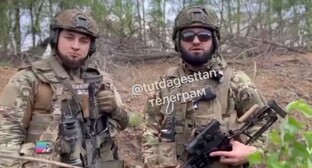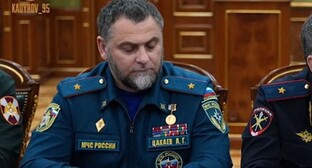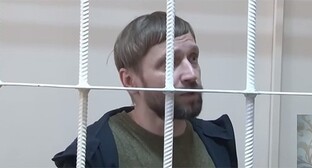25 January 2004, 15:07
Chechnya, 2003: abductions and disappearances
Now, at this moment, residents of Gikalovsky, Chechnya, Russia, are standing at the government complex in Grozny. They demand from the leadership at least some kind of information about the destiny of two abducted people. On the night of December 1, a group of military men entered this settlement on several armored personnel carriers. They broke into two houses and without indicating the destination carried away two local residents - Omar Demilkhanov and Zelimkhan Bachaev. In doing so, they beat the families of the abducted people. Nothing has since been heard of Demilkhanov and Bachaev. Ibrahim Suleimanov, deputy military commandant of Chechnya, came out to the meeting and promised to do everything possible. However, the government has not been able to tell the residents of Gikalovsky something intelligible by now.
Two days ago, Interfax quoted Chechnya's Deputy Prime Minister Movsar Khamidov saying on December 1: "More than 400 residents have been abducted or missing in Chechnya this year." He remarked the number of abductions was declining as compared with the previous year. "The dynamics are on the wane presently. This is the result of quick response to cases of people's disappearances. The president of Chechnya is paying increased attention to solution of this problem, and the republican Ministry of Internal Affairs (MIA) has been more efficient."
Here, probably, it is quite appropriate to recall what figures officials had quoted earlier this year to describe the number of abductions and disappearances. We can see very impressive "leaps" of the figures.
Thus, Movsar Khamidov reported on May 11 this year that 245 people had been missing since the start of the year (54 people a month). Three months later, on August 19, he told Interfax: "Two hundred and sixty-seven people were abducted in Chechnya in the first half of the year." That is, one is to conclude from there that 22 people were abducted or missing during three months, seven people a month. If this really were so, it would mean abductions of people have nearly been curbed in Chechnya! In another two months, on October 20, Movsar Khamidov told Interfax about 300 people abducted or missing in Chechnya from the start of the year. That is, about 17 people a month disappeared between August 19 and October 20. And now, a month later, the figure is 400 missing people. Does it mean that 100 people became missing during November according to official information?
I believe this would be the wrong conclusion. This rather indicates that any such information provided to the public is not final, not complete. It can alter, very significantly, as it is specified and systematized, if any real work on it is handled at all, of course.
We are much more perplexed by the figures of Chechnya's MIA.
Internal Affairs Minister Alsu Alkhanov told ITAR-TASS on August 18 that 380 people were missing in Chechnya from the start of the year. Two months pass, and the republican MIA tells the same agency the same figure - 380 people - on October 20. How can information from this ministry be taken seriously after this?
Now for our information.
We keep A Chronicle of Violence in the Armed Conflict Area in which day by day we post information we learn about murders, abductions, explosions, assaults, firings, "clean-up operations," and so on. We mark all cases of violence, no matter which of the parties commits them. We try not to speak about an event in general, not only about the number of victims, but always, if possible, we report specific people's names and addresses. Every time when human rights are violated, we file inquiries to the prosecutor's office, demanding their investigation and seeking legal action. Cases when we received answers from there that no such event had occurred are very rare, about a dozen over the entire "second Chechen war." But even so, further examination in half of the cases enabled us to prove that the prosecutor's office was wrong, not us. To my mind, this is good evidence of the reliability of our information.
We have distributed among you some excerpts from our Chronicles for October and November - it is all about abductions of people here. Who abducts them? The military, special police units sent to Chechnya, the Federal Security Service (FSS), officers of Chechnya's law enforcement and security agencies, guerillas, and just criminals. But if you read our Chronicle attentively, you will see that in a substantial majority of cases it is quite obvious that those are responsible for such crimes who are called "federals" and those who are called "Kadyrovites." At the same time, over the past year Chechnya's law enforcement and security agencies have been participating in such crimes more and more frequently, independently or in association with FSS people and the military.
In the chart we have distributed among you, we quote monthly figures on abductions we learned about in January-November 2003.
|
Months |
People abducted |
Released or ransomed |
Found murdered (almost always with traces of torture) |
Missing |
|
Jan. |
64 |
20 |
12 |
32 |
|
Feb. |
66 |
25 |
11 |
30 |
|
Mar. |
20 |
6 |
4 |
10 |
|
Apr. |
42 |
12 |
2 |
28 |
|
May |
32 |
6 |
4 |
22 |
|
June |
46 |
17 |
3 |
26 |
|
July |
43 |
11 |
1 |
31 |
|
Aug. |
44 |
9 |
8 |
27 |
|
Sept. |
22 |
19 |
- |
3 |
|
Oct. |
26 |
7 |
2 |
17 |
|
Nov. |
26 |
5 |
- |
21 |
|
Total |
431 |
137 |
47 |
247 |
Firstly, the number of abductions and disappearances that have occurred in Chechnya over the year is not exhausted with these figures. Memorial is capable of extending its monitoring only to a limited part of the republic, approximately 25-30% of its territory. Other areas, including in the mountains, remain inaccessible to our staff. Meanwhile, the situation there is tense, murders and abductions are committed almost every day. But even in the areas we can monitor, Memorial can hardly provide exhaustive coverage. We estimate the total number of crimes against civilians in Chechnya may be approximately 3-4 times Memorial's figures.
Secondly, one should also take into account, proceeding from monitoring specifics in Chechnya, that figures for the last two months are always understated, being gradually specified during the next few months. That is why, unfortunately, the number of abductions in October and November 2003 will inevitably grow.
Thus, we are convinced the figure provided by Movsar Khamidov is obviously understated comparing with reality.
Considering that the figures for October and November are yet to grow, abductions will be about 15-17% fewer this year comparing with the previous one.
To our mind, it is not worthwhile talking about any "positive dynamics" on this basis, less so that government actually has a real resource to cut down drastically the number of abductions and subsequent disappearances of people.
Let's take a look at our chart, by months.
The beginning of the year shows increase in the number of abductions and murders of the abducted people. This was already to been seen at the end of last year, though. One can assume this is how federal forces stepped up "working to establish order" in Chechnya after the hostage-taking in Moscow in October last year, eliminating those who can be suspected of contacts with guerillas. That time even Kadyrov started to talk about abductors of people going around in armored personnel carriers and military trucks, and responsibility of the military for those crimes.
Later, in March, on the threshold and during the referendum, we observe a drastic decrease in the number of abductions. There was a need that time to ensure a favorable background to carry out that undertaking. The military and police then suddenly became extremely courteous at all posts.
Then again, from April to August we register the same level of such crimes as was typical for most months of 2002.
September comes and brings preparation for the presidential election in Chechnya, and again, there is a drastic fall in abductions! On top of that, 19 out of 22 abducted people (those cases we came to learn about) were released by the abductors!
Isn't there enough evidence that those who abduct, torture, and murder people are at least controlled by government? When a political necessity occurs, the government says "STOP!" to them. This means it has a resource for a sharp decline in abductions.
What government is it all about?
We believe it's all about government at various levels. Kadyrov controls his law enforcement and security agencies well enough. The military command, the Regional Operative Headquarters can exert pressure on various special forces (the MIA interior troops, the Main Intelligence Administration, etc.) and special police units at least to cut down the number of abductions they carry out.
However, there is obviously no wish to stop this criminal practice. It is obvious a lot of people from law enforcement and security agencies believe it correct to fight terrorism with the help of terror.
It is obvious the Russian president has no political will to that, either.
Let's recall that human rights advocates had for several years demanded cessation of the barbarian practice of "clean-up operations." Such operations often led to disappearances of detainees. Finally, at the end of last year Putin announced cessation of these operations and switching to the tactics of "targeted special operations." "Clean-up operations" did not stop in Chechnya, but they dropped in number drastically. At once, though, the number of people abducted in the course of "targeted special operations" drastically increased.
What is the total number of people that disappeared during the second Chechen war (October 1999 - 2003) as a result of abductions, illegal detentions, night-time "targeted special operations," and "clean-up operations"? I think no exact figures are available here.
One can quote only approximate minimal estimates. We believe more than 3,000 people disappeared this way. How many more? We don't know. I would like to emphasize I don't include those in this approximate figure who became missing during combats, bombings, etc. I also emphasize that in the absolute majority of these cases, the matter under discussion is about terror purposefully carried out by federal government in Russia.
Is it many or not? Obviously, every time a person disappears this way is an outrage, and every such case should become the subject of serious investigation. Yet how can one assess the scale of developments in Chechnya?
In itself, the figure on murders and abductions in Chechnya cannot give a notion of the nightmare going on there.
Let's compare.
In 1937-38, in the period of Stalin's big terror, officers of the People's Commissariat of Internal Affairs (NKVD) came by night, arrested people, shot them after torture and a parody of trial, and often told their relatives that they had been sentenced for ten years in remote camps with no right to correspondence. Hundreds of thousands of people disappeared this way. Overall, about 0.75 million people were executed in the big terror years out of the Soviet Union's population which made about 170 million then - 44 per 10,000 citizens.
Nowadays in Chechnya, armed people in masks coming at night by armored personnel carriers or other vehicles with no license plates break into houses and carry away their hosts without indicating the destination. In doing so, they easily go by all posts of law enforcement and security agencies. As for the people they carry away, they "disappear." Sometimes, relatives of missing people find their bodies with traces of torture. No more than 0.7 million people live in Chechnya currently, according all serious assessments (the census figures should be referred to as unscientific science fiction). This means, according to minimal calculations, every 10,000 residents of Chechnya account for 44 victims of state terror carried out in the form of abductions and following disappearances of people.
Author: Oleg Orlov, Сhairman of the Board, Human Rights Center Memorial Source: Memorial Human Rights Center (Moscow, Russia)




